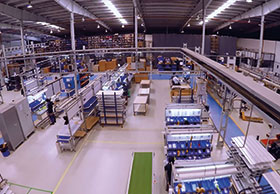

The most frequent cause of electrostatic charge in process plants is charge carryover when filling vessels such as fuel tankers, barrels, big bags or intermediate bulk containers (IBCs). An electrostatic discharge can produce a spark, which can cause a combustible mixture of gases and dusts to ignite. Discharge in potentially explosive atmospheres must therefore be avoided. The most important countermeasure is a safe discharge by means of potential equalisation or electrostatic earthing.
Earth monitoring devices are increasingly being used on portable containers to establish and simultaneously monitor this connection. In this critical loading area, the connections are subject to a high mechanical load, which can lead to interruptions. Earth monitoring devices are able to detect insufficient discharge, notify the user accordingly, and wherever necessary, interrupt the loading process.
R. Stahl supplies earth monitoring devices for a wide variety of objects, such as tanker lorries, tank wagons, drums, etc. The earthing systems use robust stainless steel clamps and options such as automatic retraction and other practical accessories make the product easy to use.
Devices in the 8125 and 8146 series provide earthing without object recognition and can be used universally, while 8485 series devices check the quality of the earth connection and detect whether the earthing clamp has been correctly secured to the object that is to be filled, and that it has not accidentally been secured to the loading equipment. This automatically eliminates the possibility of improper use.
• Solutions for Zones 1, 2, 21 and 22.
• Solutions designed for a variety of objects such as tanker lorries, tank wagons, drums or FIBCs.
• User-friendly extras such as coiled cables and automatic retractors plus a wide range of accessories such as horns, beacons and key-operated switches.
Fuel tankers
Loading and unloading tankers can mean large quantities of liquid or powdered materials are moved in a short period of time. The resulting electrostatic charges are safely discharged via series 8485 earthing devices. In addition to the continuous monitoring of earthing, these devices have the added benefit that they detect the ‘fuel tanker’ object after the connection is made and thus exclude operator errors. The two-channel version is ideal for combined loading and unloading stations for fuel tankers and rail wagons.
Barrels, IBCs and rail wagons
Solutions in this application area directly monitor earthing via the connected clamps. The electrostatic charge caused by loading and unloading or moving liquids is safely discharged and the connection for potential equalisation is monitored. Using a contact, the loading process can be interrupted or additional signalling triggered for the user. The robust and simultaneously lightweight devices made from stainless steel or glass fibre reinforced plastic are easy to install.
Big bags
The latest generation of the 8485 series devices monitors the discharge capability of flexible intermediate bulk containers (or big bags). The discharge capability of these containers continually decreases during use due to loading and abrasion. The device monitors the limiting value and signals, if this value is exceeded by means of indicator lamps and monitoring contacts. The contacts can be used to interrupt the loading process in the event that a limiting value is exceeded.
For more information contact Preshan Moodliar, Stahl Esaco, +27 (0)11 608 3120, preshan@esaco.co.za, www.esaco.co.za

© Technews Publishing (Pty) Ltd | All Rights Reserved